|
Getting your Trinity Audio player ready...
|
The sun hasn’t risen, but cars creep into pullouts off the NE Entrance Road – half awake, bundled passengers brave the frigid temps and begin their rituals. Scopes pointed at the horizon, they’re looking for something.
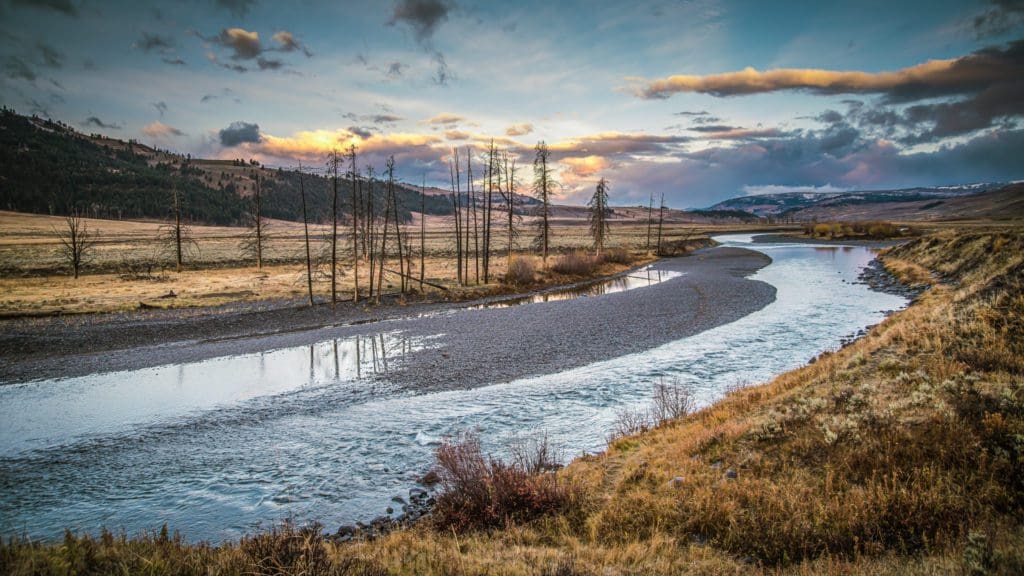
Early morning in the Lamar Valley in Yellowstone National Park
We’ve driven this morning from Upper Hell Roarin’ to the middle of the Lamar Valley. This morning – this early – the Bison we pass on our commute are covered in frost, standing upright but frozen in time. The sky is lighting up in muted purples and blues. We’re looking for wolves, or rather, we’re looking for the people who look for the wolves.
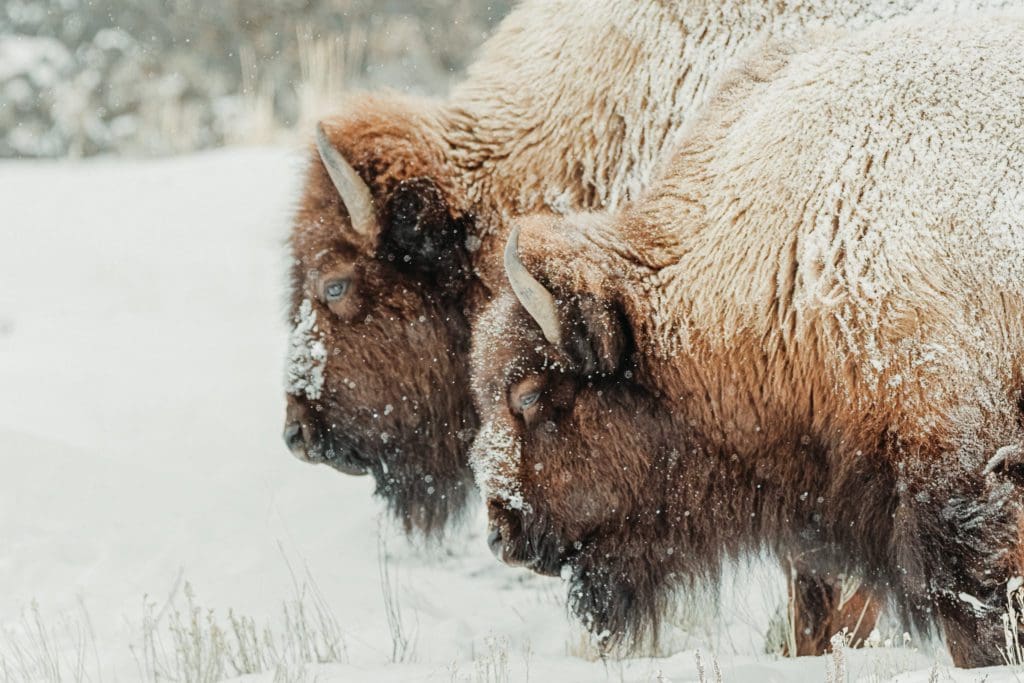
Bison are covered in frost in the Lamar Valley, Yellowstone National Park, Wyoming.
It’s January 2022 in Yellowstone National Park and most of the park is closed. There’s one road open from Gardiner to Cooke City – the Northeast and Northern Entrances. Still, the amount of viewable wildlife is astonishing: big horn sheep, coyotes, eagles, moose, bison, and wolves. This little corridor gives tourists a short glimpse of a thriving, protected, and balanced ecosystem.
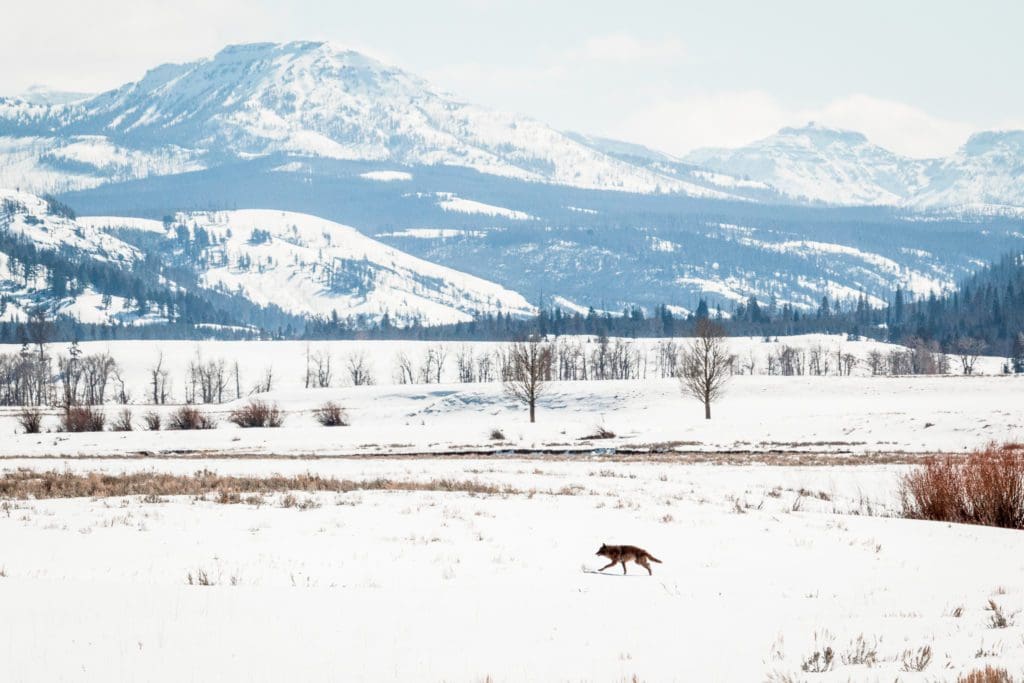
Gray Wolf crossing the Lamar Valley in Yellowstone National Park.
Along this sliver of plowed pavement, novice and professional biologists alike gather to scan the landscape for one thing: wolves. That’s who we’re here for, these folks. Because you see, they’re in the thick of it every day, snow or shine, warm or cold (and man, does it get cold). This quirky gaggle of wolf groupies can spot a gray lump through a Swarovski Scope from a mile away and tell you its name, its siblings, and its attitude. They roll into scenic pullouts at the crack of dawn – look, listen, and wait. Since reintroduction in the 90s, wolves have become a staple in the park and these “wolf watchers” have been coalescing since – making Yellowstone one of the premier places to spot and study the storied creatures.
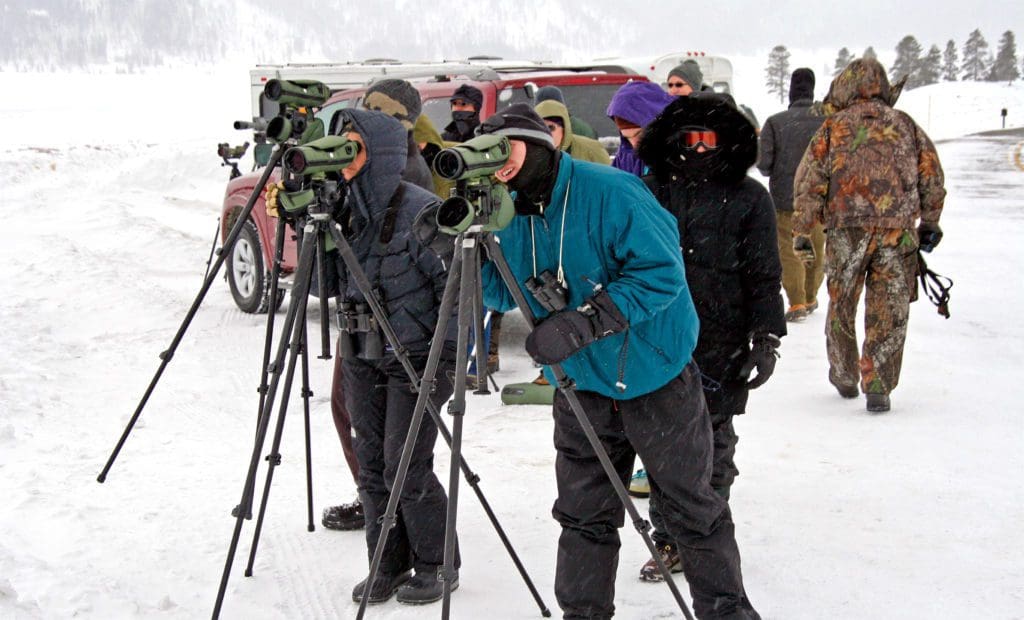
Hobby and career biologists track and study wolves in the Northern Tier of Yellowstone National Park, which is documented in the film, Wolf Watchers.
Good To Know: The documentary short film, WOLF WATCHERS, Directed by Olivia Belluck and Claire Barber has won Best Cinematography Awards at film festivals in Los Angeles, CA and Portland, OR during 2022. More information below.
I traveled to Yellowstone for three weeks as part of a film crew to document the wolf watching community and to contextualize the community against changes and tensions occurring in and around the park: increased tourism, reintroduction in Colorado, new, more liberal hunting regulations in Wyoming, Montana, and Idaho, and the future of the wolf watching community itself. Most recently, wolves were relisted on the endangered species list.
It would be my first time heading to the park in the winter, and, to say the least, January conditions in Yellowstone are notoriously not ideal. My co-producer had spent time wolf watching years before: “the wolf watchers will head out even when its -40.” God. -40?
So, in pre-production, we planned for every scenario – particularly the cold kind. I think we stocked up on over 100 hand and toe warmers, coolers to insulate our batteries, snow spikes, gaiters, layers on layers (you get the gist). But for an amateur film shoot, to get past permitting, your whole crew must be contained in a single vehicle. So, we traveled light, but with an enormous number of batteries and hand warmers (you could use the word paranoid).
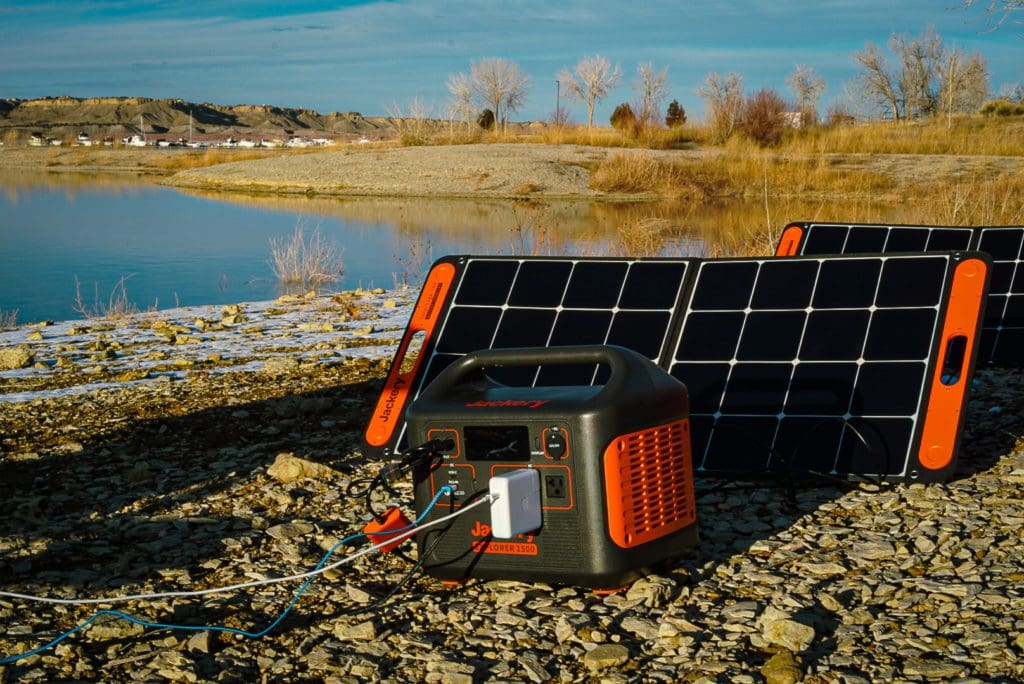
THE JACKERY SOLAR GENERATOR 1500: The Solar Generator 1500 is integrated in combining with the Jackery Explorer 1500, and 4 SolarSaga 100W solar panels together.
The biggest hurdle to our shoot was keeping things charged in the extreme temps. In anticipation of the dying batteries and the challenges of running and gunning from the back of a Jeep Wrangler, Jackery sent me their 1500 model generator to test in the field. I was skeptical, but the battery did not disappoint.
The battery itself served as our go to power station in and out of the vehicle. Most frequently, the generator powered a set of radios, four lavalier batteries, and two Sony FW50 batteries. On a particularly cold day (I think it was around 1 degree), we were on shoot into the late morning, operating cameras. No surprise, I lost feeling in my fingers. Hesitant to start the car (the noise can be disruptive when folks are listening for howling wolves), I ran a 200 Watt Lasko Heater without a hitch. On any given day, the battery never dropped below an 84% charge.
The generator itself is about the size of a personal cooler and weighs around 35 lbs. I was most impressed by the generator’s maneuverability and ease of use. No, I wouldn’t plan on packing the battery out several miles, but if you’d be comfortable lugging a cooler full of beers to a spot, you can definitely get a Jackery 1500 to the same place.
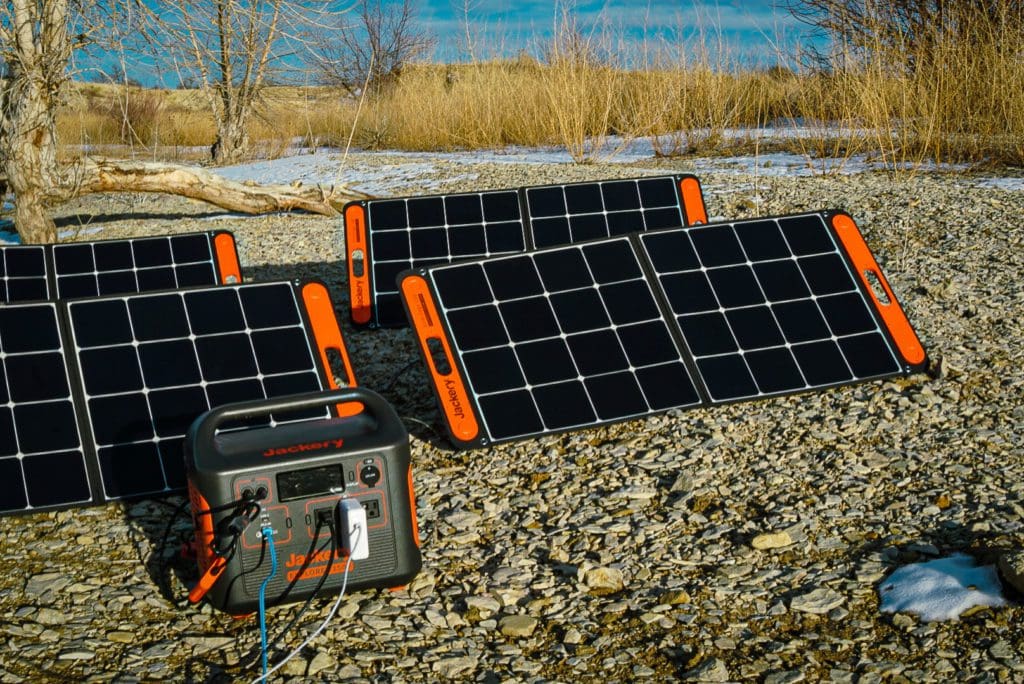
The Jackery 1500’s charging ports and display are particularly accessible.
The charging ports and display are particularly accessible. There are 3 AC ports, 2 USB-A ports, a USB-C port, and a car output/DC input. I could easily charge my computer, my camera batteries, and run the heater with outlets and battery life to spare. A downside – while the battery can handle a crazy number of devices, the minutia of keeping track of the batteries, phones, and radios was a little nightmarish. The top of the generator is slightly rounded. Not a dealbreaker, sure, but batteries and phones don’t sit well on top of it. Some of our batteries and devices jostled around in the Jeep and would unplug themselves. If the top of the generator had a grip of some sort (which an industrious person could easily add) then the problem would easily be solved.
Overall, the Jackery was an essential on our shoot, and its power capabilities even overkill at times. At night, I would bring the generator back to our cabin and use it as our command station – all our devices got plugged in (bonus, you can charge the Jackery while charging other devices). It felt silly to use a generator indoors, but it kept all our devices in one place and easily accessible. Since we could charge it up at night using the cabin’s wall outlet, its extended storage capabilities weren’t always needed day-to-day (but nice to have as peace of mind). If you’re a photographer or videographer in a similar situation, you could consider the smaller models, like the Jackery 1000.
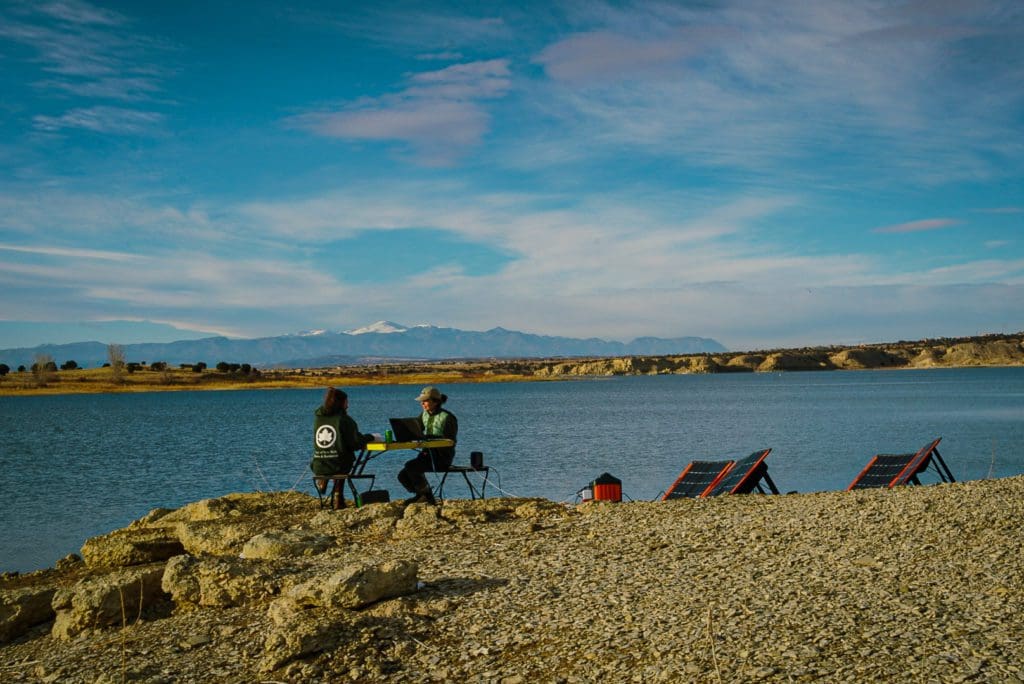
The Jackery 1500 generator provided reliable power for our photography essentials including camera batteries, computers, and phones.
If I was heading out on a multi-day shoot without reliable power, based off the 1500’s performance on our shoot, I would trust the Jackery to charge my essentials like camera batteries, computers, and phones. The battery boasts impressive watt hours and running wattage, 1534Wh and 1800 running wattage, respectively, but some of Jackery’s metric’s for its capacity are a little wonky. Sure, the company says that the battery can power a 1000w microwave for 68 min or a 900w pressure cooker for 75 minutes, but I really don’t care. The biggest thing is that the battery can charge my essentials without losing egregious amounts of battery power, and bonus, the generator can power a small heater for an extended period of time.
I never ran my 200 Watt heater for long in the cold while in Yellowstone (although battery power never dropped significantly when I did run it), but a rough working time estimate approximates that the heater could run for 6.3 hours.
If you’re planning to heat a van daily with this generator though, you might want to reconsider (you’d be needing to recharge it daily). But for particularly cold nights or winter camping trips, its nice to have the option to run one if need be.
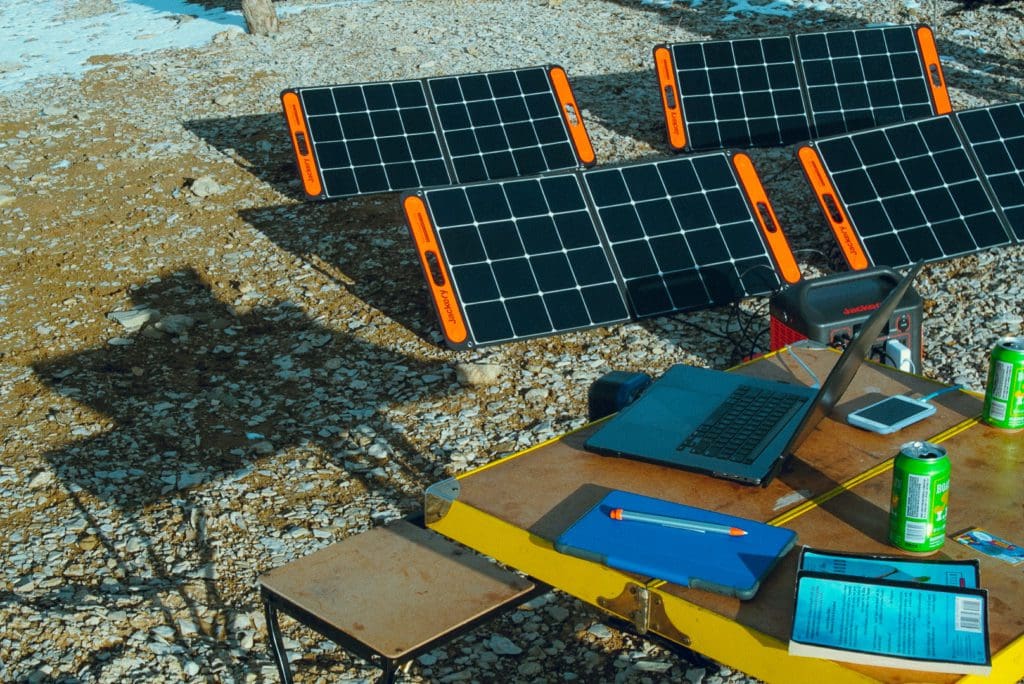
The biggest thing is that the battery can charge my essentials without losing egregious amounts of battery power, and bonus, the generator can power a small heater for an extended period of time.
When I returned home to Colorado, I decided to test out the capability of the Jackery solar panels themselves. I set up the generator with four Solar Saga 100 W panels in the mid-afternoon. With a whopping UV Index of zero, the four panels were still pulling in 100-150 watts (to emphasize, the sun was abysmal). We ran the 200 W Lasko Heater and charged a computer and phone. For the 2 ½ hours we were out there, the generator dropped from a 100% charge to 96%.
The panel setup itself isn’t discrete and takes up space, but for the capacity and efficiency of the panels, that’s to be expected.
The panels themselves are light and portable, weighing in at 9 lbs each one has 1 USB-C and USB-A port, so you could charge devices straight from the panels if you needed to. They’re extremely easy to prop and setup, and close magnetically when you have to store them away. The only critique – the panel cables for the generator are stored and tucked away in a pouch on each panel (very nice) but the cable ends don’t have protective covers. Be extra careful when you’re pulling the cables out, the nodes grab mud super easily and are a little tricky to clear.
All in all, the Jackery 1500 is a beast of a solar generator. For the power it generates, its footprint is small and the whole operation is virtually noiseless (there’s a small hum occasionally). If you’re planning to adventure for 1-2 days at a time and only need to keep a phone charged though, this unit is overkill – spring for one of their smaller options or even just a single panel. The panels are water resistant but not waterproof – so I wouldn’t count on generating power from the panels when its snowing or raining, but the 1500 holds enough charge to carry your essentials through the fray if needed.
All in all, an essential piece of gear for film or photography shoots that might need the extra battery support, and a killer, relatively low-cost option for van-lifers and car campers alike.
WOLF WATCHERS, 15min., USA, Documentary. Braving the realities of the harsh Montana winter and changing hunting regulations, hobby and career biologists track and study wolves in the Northern Tier of Yellowstone National Park. While the fate of wolves remains uncertain, the devotion and passion of Yellowstone’s Wolf Watchers are always a constant. Directed by Olivia Belluck, Claire Barber
Official Selection: 2022 Oregon Documentary Film Festival, September 2022
Best Cinematography: 2022 Oregon Documentary Film Festival, September 2022
Best Cinematography: 2022 Los Angeles Documentary & Short Film Festival, September 2022
Jackery Solar Generator 1500 Pro (Explorer 1500 Pro + SolarSaga 200W)
Jackery Solar Generator 1500 Pro stands out with its ultra solar charging and fast charging capabilities. Recharging your generator can be done within two hours due to its maximum 1,400W solar power input and six 200W solar panels. This powerful, reliable and durable device has passed the highest UL requirements, with the outer shell made of 94V-0 fireproof material, and has exceeded safety drop standards. Weighing just 37.4lbs, it is 20% lighter than similar products with the same capacity and is fitted with a foldable handle for easy portability. Experience power on the go with Jackery Solar Generator 1500 Pro.
[2,099.00 at jackery.com]
Get It Now!
Popular Articles:
The 10 Best National Parks in the USA
Adventurer’s Guide to Yellowstone National Park
Top Adventure Sports Towns 2021: Jackson, Wyoming
Goodbye Gas Generator, Hello Yeti 1500X Power Station
Dometic’s PLB40 Ah Lithium Iron Phosphate Battery Delivers












